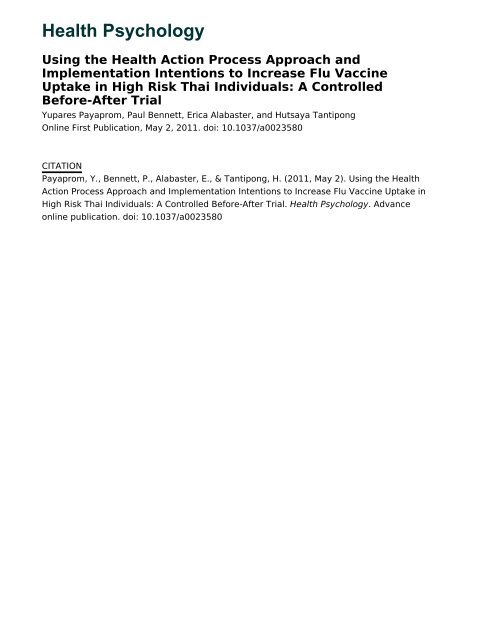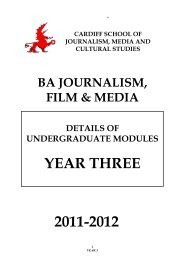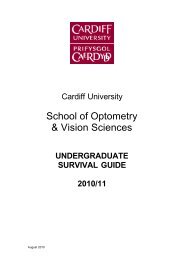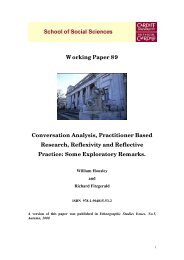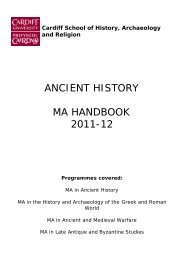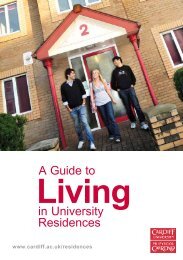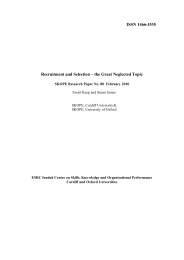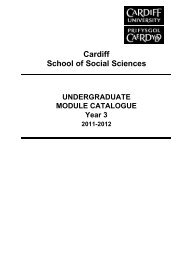Health Psychology - Cardiff University
Health Psychology - Cardiff University
Health Psychology - Cardiff University
Create successful ePaper yourself
Turn your PDF publications into a flip-book with our unique Google optimized e-Paper software.
<strong>Health</strong> <strong>Psychology</strong><br />
Using the <strong>Health</strong> Action Process Approach and<br />
Implementation Intentions to Increase Flu Vaccine<br />
Uptake in High Risk Thai Individuals: A Controlled<br />
Before-After Trial<br />
Yupares Payaprom, Paul Bennett, Erica Alabaster, and Hutsaya Tantipong<br />
Online First Publication, May 2, 2011. doi: 10.1037/a0023580<br />
CITATION<br />
Payaprom, Y., Bennett, P., Alabaster, E., & Tantipong, H. (2011, May 2). Using the <strong>Health</strong><br />
Action Process Approach and Implementation Intentions to Increase Flu Vaccine Uptake in<br />
High Risk Thai Individuals: A Controlled Before-After Trial. <strong>Health</strong> <strong>Psychology</strong>. Advance<br />
online publication. doi: 10.1037/a0023580
<strong>Health</strong> <strong>Psychology</strong><br />
© 2011 American Psychological Association<br />
2011, Vol. ●●, No. ●, 000–000 0278-6133/11/$12.00 DOI: 10.1037/a0023580<br />
Using the <strong>Health</strong> Action Process Approach and Implementation Intentions<br />
to Increase Flu Vaccine Uptake in High Risk Thai Individuals:<br />
A Controlled Before-After Trial<br />
Yupares Payaprom<br />
<strong>Cardiff</strong> <strong>University</strong><br />
Erica Alabaster<br />
<strong>Cardiff</strong> <strong>University</strong><br />
Paul Bennett<br />
<strong>University</strong> of Swansea<br />
Hutsaya Tantipong<br />
Chiang Rai Hospital, Chiang Rai, Thailand<br />
Objective: Influenza vaccination rates remain suboptimal in many countries, including Thailand. This<br />
study compared the effect of a theory-based educational leaflet, based on the <strong>Health</strong> Action Process<br />
Approach (HAPA), and action planning intervention with a standard government information leaflet<br />
designed to increase influenza vaccination uptake among high-risk Thai adults. Design: A controlled<br />
before and after trial was conducted. Participants in the intervention (n 99) received a leaflet based on<br />
the HAPA and asking them to form an action plan identifying where, when, and how they would seek<br />
vaccination. Those in the comparison condition (n 102) received a standard government information<br />
leaflet. Main Outcomes Measures: There are 2 sets of outcome measures: (a) process measures of HAPA<br />
related variables taken at T1 and T2, and (b) vaccination rates during the subsequent 2 months. Results:<br />
The HAPA intervention resulted in greater changes on measures of risk perception, outcome expectancies,<br />
self-efficacy, and intention than the comparison condition. Stronger intentions to obtain vaccination<br />
were explained by changes in outcome expectancies, perceived self-efficacy for arranging time and<br />
transportation, and planning. No significant difference in vaccination rates was observed between two<br />
groups. Influenza vaccination was directly predicted by self-efficacy and intention. Conclusion: Results<br />
demonstrate that a HAPA-based leaflet may be a useful tool to enhance individual’s vaccination<br />
intention, but larger trials are required to confirm these findings.<br />
Keywords: before-after study, influenza vaccination, <strong>Health</strong> Action Process Approach<br />
Each year, influenza epidemics are estimated to cause 3–5<br />
million cases of severe illness, and between 250,000–500,000<br />
deaths throughout the world (World <strong>Health</strong> Organization [WHO],<br />
2003). In Thailand, an outbreak of the influenza A (H5N1) virus in<br />
2004 resulted in 17 confirmed cases and 12 deaths, while 8.4<br />
million people were infected and 191 died in the 2009 influenza A<br />
(H1N1) pandemic (Ministry of Public <strong>Health</strong> [MOPH], 2009).<br />
Together, these highlight the need for the development of an<br />
influenza prevention and control program in Thailand. The program<br />
has so far made free vaccination available to all health care<br />
Yupares Payaprom and Erica Alabaster, <strong>Cardiff</strong> School of Nursing and<br />
Midwifery Studies, <strong>Cardiff</strong> <strong>University</strong>, <strong>Cardiff</strong>, United Kingdom; Paul<br />
Bennett, Department of <strong>Psychology</strong>, Swansea <strong>University</strong>, Swansea, United<br />
Kingdom; Hutsaya Tantipong, Department of Medicine, Chiang Rai Hospital,<br />
Chiang Rai, Thailand.<br />
We thank all the study participants for their cooperation in following all<br />
requirements of the study. This research project was partially supported by<br />
funds to Yupares Payaprom from the Thai government.<br />
Correspondence concerning this article should be addressed to Yupares<br />
Payaprom, Nursing, <strong>Health</strong>, and Social Care Research Centre, <strong>Cardiff</strong><br />
<strong>University</strong>, Eastgate House, 4th floor, 35-43 Newport Road, <strong>Cardiff</strong>, CF 24<br />
0AB, United Kingdom. E-mail: PayapromY1@<strong>Cardiff</strong>.ac.uk<br />
workers involved in direct patient care and those who have at least<br />
one chronic disease (Ministry of Public <strong>Health</strong>, 2008). Unfortunately,<br />
the vaccination rate during the program’s first year was relatively<br />
low (37.7% in Chiang Rai Province, P. Sriwongpan, personal<br />
communication, March 6, 2009): insufficient to provide population<br />
protection against the virus.<br />
Factors that influence decisions in relation to vaccination are<br />
complex. They include knowledge and beliefs about influenza and<br />
the flu vaccine, perceived risk for influenza, health status, concerns<br />
about the efficacy and side effects of vaccine, health care providers’<br />
recommendations, social influences such as family and<br />
friends, and the availability of the vaccine (e.g., Burns, Ring, &<br />
Carroll, 2005; Evan, Prout, Prior, Tapper-Jones, and Butler, 2007).<br />
These factors provide a number of targets for any public health<br />
program designed to increase uptake of influenza vaccine. Theoretical<br />
models also help determine the content of any program, and<br />
can be utilized to explain how it promotes any behavioral change<br />
(Fishbein & Yzer, 2003). The <strong>Health</strong> Action Process Approach<br />
(HAPA; Schwarzer, 2001) provides one such explanatory model,<br />
and has been shown to have good predictive utility in relation to a<br />
number of health-related intentions and behaviors including diet<br />
(Schwarzer & Renner, 2000), alcohol consumption (Murgraff,<br />
McDermott, & Walsh, 2003), breast self-examination (Luszczynska<br />
& Schwarzer, 2003), physical exercise (Schwarzer, Luszczyn-<br />
1
2 PAYAPROM, BENNETT, ALABASTER, AND TANTIPONG<br />
ska, Ziegelmann, Scholz, and Lippke, 2008), and food hygiene<br />
(Chow & Mullan, 2010).<br />
According to the HAPA, changing health behaviors involves<br />
two interacting phases. The motivation phase is influenced by risk<br />
perception, outcome expectancies, and perceived self-efficacy.<br />
Together, these variables influence intentions to perform specific<br />
behaviors (e.g., Luszczynska & Schwarzer, 2003; Schwarzer,<br />
2001). After a goal intention has been established, the individual<br />
enters the volition phase. In this, action planning (Schwarzer,<br />
2001) or the analogous process of developing implementation<br />
intentions (Gollwitzer, 1999) play an important role in bridging the<br />
intention-behavior gap. Intentions are most likely to be acted on if<br />
the individual develops an action plan/implementation intention<br />
(Gollwitzer, 1999; Pestwich, Ayres, & Lawton, 2008; Sniehotta,<br />
Soares, & Dombrowski, 2007). Summarizing the available data, a<br />
meta-analysis of 94 studies conducted by Gollwitzer and Sheeran<br />
(2006) indicated that action plans/implementation intentions had<br />
an overall effect size of .65 on goal attainment.<br />
The present study investigated whether a leaflet addressing<br />
variables identified as relevant by the HAPA and incorporating<br />
action planning would result in higher intentions to seek influenza<br />
vaccination and vaccination rates than a standard government<br />
leaflet among high-risk Thai individuals. The study also investigated<br />
the explanatory power of the HAPA in relation to influenza<br />
vaccination. It was hypothesized that: (i) implementation of a<br />
theory-based leaflet and action planning intervention would lead to<br />
greater changes in key mediator variables (knowledge, risk perception,<br />
self-efficacy, outcome expectancies, intention to seek<br />
vaccination) and higher rates of influenza vaccination than a<br />
comparison intervention; (ii) changes in risk perceptions, outcome<br />
expectancies, self-efficacy, and establishing an action plan would<br />
be associated with changes in intentions to vaccinate over time;<br />
and, (iii) establishing an action plan, self-efficacy, and intentions<br />
would predict vaccination uptake.<br />
Method<br />
Study Setting<br />
The study was conducted in the Muang district, an urban community<br />
in Chiang Rai province, the northernmost province of<br />
Thailand, with an adult literacy rate of 93.8% (National Statistical<br />
Office, 2006). The Chiang Rai province research ethics committee<br />
approved the study. The study was conducted in two geographically<br />
separated communities to limit contamination between trial<br />
arms. These two areas were similar in overall population size, the<br />
number of people with chronic diseases requiring influenza vaccination<br />
within them, and the baseline influenza vaccination rate<br />
among high-risk people.<br />
Design and Participants<br />
A controlled before and after trial was carried out comparing the<br />
effect of a HAPA-based leaflet with a standard government information<br />
leaflet on influenza vaccination uptake among high-risk<br />
urban dwelling Thai adults. Participants were randomly selected<br />
from pools of eligible participants in two geographically separate<br />
communities within the Muang district. Participants in one area<br />
received a HAPA-based leaflet; those in the other received a<br />
standard government leaflet. The study had two sets of outcome<br />
measures: (i) process measures of HAPA related variables taken at<br />
Time 1(T1) and 2 weeks after the intervention (Time 2: T2); and<br />
(ii) vaccination rates during the subsequent 2 months. The study<br />
was powered to detect between group differences in vaccination<br />
rates of 22% (between the previous year’s vaccination rate of 38%<br />
and a predicted rate of 60%). This required a sample size of 177<br />
participants with a power of 0.80 at a significance level of 0.05<br />
(Fleiss, Levin, & Paik, 2003). The study was confined to people<br />
aged 45–65 years with one or more chronic diseases (including<br />
heart disease, diabetes, and asthma) indicating the need for a flu<br />
vaccination. Exclusion criteria were: (1) having a known or suspected<br />
egg protein allergy; (2) hypersensitivity to any component<br />
of the vaccine; (3) severe chronic conditions (i.e., bed bound or<br />
acutely ill); (4) dementia or suspected dementia, or (5) an inability<br />
to read and write.<br />
Potential participants in each area were identified from the<br />
National <strong>Health</strong> Security Office list. Of the 594 potential participants,<br />
401 met all the eligibility criteria. Of these, 205 were<br />
randomly selected to participate in the study using a lottery method<br />
without replacement. Four participants withdrew before completing<br />
the baseline questionnaire. Accordingly, 201 participants were<br />
included in the study (99 in the intervention group and 102 in the<br />
comparison group; see Figure 1). The study population had a mean<br />
age of 56.24 [SD 5.86] years, with a range of 45–65 years. The<br />
majority of participants (66.67%) were female, most (94.12%) had<br />
completed primary school (6 years of schooling), and 88.24% were<br />
married. Participants in each group did not differ with regard to<br />
age (t 1.7, df 199; p .09), gender ( 2 1.76; p .18),<br />
marital status ( 2 7.05; p .07), educational level ( 2 4.96;<br />
p .17), occupation ( 2 2.24; p .53), and prior flu immunization<br />
( 2 3.14; p .08). Only three people, all of whom were<br />
in the HAPA condition, had received one flu vaccination prior to<br />
the intervention.<br />
Intervention<br />
Participants in the HAPA condition received a leaflet addressing<br />
factors known to influence behavior: risk perception, outcome<br />
expectancies, self-efficacy, intentions, and action planning<br />
(Schwarzer, 2001). The behavior change techniques used in the<br />
leaflet included providing information about the behavior-health<br />
link (Abraham & Michie, 2008). This involved highlighting high<br />
risk individuals’ susceptibility to influenza and its complications<br />
(e.g., “You are at high risk for severe complications such as<br />
pneumonia, and blood infections. This may put you in the hospital,<br />
so why risk it?”). The messages focused on increasing perceptions<br />
of personal risk rather than arousing fear of disease (see Ruiter,<br />
Abraham, & Kok, 2001).<br />
A second behavior change technique involved providing information<br />
on the benefits of vaccination. This involved phrases including<br />
“Taking the flu shot will help you a lot through the flu<br />
season: Don’t get the flu!,” “Don’t have serious complications,”<br />
and “Reduce the risk of going into hospital.” The leaflet also<br />
sought to increase participants’ efficacy in relation to their ability<br />
to cope with the vaccination by including the personal accounts of<br />
people who had received the influenza vaccination (e.g., “I have<br />
asthma, I need to protect myself. At first, I had not agreed to get<br />
the flu shot because I was afraid of allergies and breathing diffi-
INCREASING FLU VACCINATION UPTAKE<br />
3<br />
Baseline assessment<br />
Assessed for eligibility (n=594)<br />
Two urban communities<br />
Enrolment<br />
Randomised allocation<br />
Control group: 1 community<br />
(Assessed for eligibility; n=320)<br />
Excluded (n=109)<br />
- Not meeting inclusion<br />
criteria (n=101)<br />
- Could not be contacted (n=5)<br />
- Refused to participate (n=3)<br />
Intervention group: 1 community<br />
(Assessed for eligibility; n=274)<br />
Excluded (n=84)<br />
- Not meeting inclusion<br />
criteria (n= 80)<br />
- Could not be contacted (n=2)<br />
- Refused to participate (n=2)<br />
Eligible individuals n=211<br />
Eligible individuals n=190<br />
105 randomly selected<br />
100 randomly selected<br />
Allocation<br />
Control group (n=105)<br />
- Received allocated intervention<br />
(n=102)<br />
- Did not receive allocated intervention<br />
(n=3)<br />
Give reasons: time constraints<br />
(completed T1questionnaire, n=102)<br />
Intervention group (n=100)<br />
- Received allocated intervention<br />
(n=99)<br />
- Did not receive allocated intervention<br />
(n=1)<br />
Give reasons: time constraints<br />
(completed T1 questionnaire, n=99)<br />
Follow-up<br />
Lost to follow-up (n=0)<br />
(completed T2 questionnaire, n=102)<br />
Lost to follow-up (n=0)<br />
(completed T2 questionnaire, n=99)<br />
Lost to follow-up (n=0)<br />
(Assessment of vaccination rate)<br />
Lost to follow-up (n=0)<br />
(Assessment of vaccination rate)<br />
Analysis<br />
Analysed Time 2 (n=102)<br />
Analysed Time 3 (n=102)<br />
Analysed Time 2 (n=99)<br />
Analysed Time 3 (n=99)<br />
Figure 1.<br />
Flow diagram of participants’ progress through the trial.<br />
culty, but I was fine after the injection.”). These accounts also<br />
sought to increase normative beliefs favoring vaccination. Following<br />
standard “if-then” protocols (Gollwitzer, 1999), the leaflet also<br />
asked participants to develop a specific plan detailing where, when<br />
and how they would obtain the vaccination (prompt specific goal<br />
setting). Additionally, they were asked to consider how they would<br />
get to the clinic to obtain the flu vaccine (prompt barrier identification).<br />
The following instructions were included in the leaflet for<br />
the intervention group.<br />
“Getting a flu vaccination: Plan ahead! You are more likely to<br />
go for having the flu shot, if you decide now about where, when,<br />
and how you will go. Please write in below when, where, and how<br />
you plan to get a flu vaccine.”<br />
“If I get an appointment letter to have the flu vaccine, then I<br />
will.....................(please write down what you plan to<br />
do, e.g., go for taking the flu shot) at...........................<br />
(please write down where, e.g., Chiang Rai Hospital, Private clinic),<br />
and I’m going to get there by...........................(please<br />
write down how you go to that place, e.g. walking, taking a bus or<br />
asking son/daughter/relatives to take you to get the flu vaccine).”<br />
Participants in the comparison group received the standard<br />
government information leaflet. This was used in the previous
4 PAYAPROM, BENNETT, ALABASTER, AND TANTIPONG<br />
year’s (2009) vaccination program, and provided information<br />
about the symptoms of influenza, brief details about the flu vaccine,<br />
possible side effects following vaccination, and the general<br />
benefits of influenza vaccination, including “flu shots help prevent<br />
the flu and its serious complications.” No details about the complications<br />
of the flu and other benefits of influenza vaccination<br />
were addressed. Accordingly, the key techniques in this leaflet<br />
were to provide information about the behavior-health link and the<br />
consequences of vaccination (Abraham & Michie, 2008). An appointment<br />
letter detailing a date and time of vaccination was also<br />
sent to all high-risk individuals.<br />
Questionnaires<br />
The questionnaires assessed changes on key HAPA variables. In<br />
addition, as information about influenza and the influenza vaccine<br />
formed an important element of the leaflet, questions related to<br />
influenza symptoms and vaccine side effects were also included.<br />
With the exception of three questions addressing planning, asked<br />
only at T2, the same questionnaire was given to participants at T1<br />
and T2. A draft questionnaire was pilot tested by 20 Thai adults.<br />
Knowledge<br />
Knowledge of influenza symptoms and vaccine side effects<br />
were assessed by presenting participants with a list of 13 symptoms<br />
(e.g., fever, watery eyes) and eight potential vaccine side<br />
effects (e.g., pain at the vaccination spot, vomiting). There were<br />
eight correct influenza symptoms and four correct vaccine side<br />
effects. Participants were asked to tick yes, no, or not sure, to<br />
the symptom and vaccine side effects checklist.<br />
Risk Perception<br />
For the measure of risk perception, participants were asked to<br />
indicate their level of agreement or disagreement with 15 statements<br />
referring to (i) the risk of developing influenza and (ii) the<br />
consequences of influenza to their lives (e.g., “If someone in my<br />
family develops flu, everyone else will,” and “Flu can make my<br />
existing illness worse”). Items were measured using a 5-point<br />
Likert scale from 1 (strongly disagree) to5(strongly agree). Total<br />
risk perception scores, ranging from 15 to 75, were calculated by<br />
summing the item scores. In addition, separate risk (Cronbach’s <br />
T1 0.79; T2 0.68) and consequence subscales (Cronbach’s <br />
T1 0.75; T2 0.70) were derived.<br />
Outcome Expectancies<br />
Outcome expectations after receiving the vaccine were assessed<br />
with seven items, including “If I get the flu shot it can prevent me<br />
from getting a more severe case of the flu,” and “If I get the flu<br />
shot it will help me stay healthy during the flu season.” All items<br />
were rated on a 4-point Likert scale from 1 (not at all true) to4<br />
(exactly true). Item scores were summed to provide a total outcome<br />
expectancy score, ranging from 7 to 28 (Cronbach’s alpha<br />
T1 .72; T2 0.81).<br />
Self-Efficacy<br />
Self-efficacy was measured by asking participants to rate their<br />
level of confidence in their ability to obtain and cope with the<br />
influenza vaccine in the next vaccination period. The scale comprised<br />
seven items, including “I am confident that I can cope with<br />
side effects after receiving the flu vaccine,” and “I am confident<br />
that I can find the time to get vaccinated against the flu.” Responses<br />
were reported on a 4-point Likert scale from 1 (not at all<br />
true) to4(exactly true). Two self-efficacy subscales were derived:<br />
self-efficacy in coping with vaccine side effects (Cronbach’s <br />
T1 0.72; T2 0.81) and self-efficacy for arranging time and<br />
transportation (Cronbach’s alpha T1 0.84; T2 0.91).<br />
Intention<br />
Participants indicated their level of intention to obtain influenza<br />
vaccination with two statements: “I intend to receive a flu shot in<br />
the forthcoming vaccination period,” and “I want to get vaccinated<br />
against the flu in the next vaccination period.” Answers were given<br />
on a 5-point scale from 1 (definitely do not) to5(definitely do).<br />
These items were added to form a sum score of intention, with total<br />
scores ranging from 2 to 10 (Pearson’s r T1 0.61; T2 0.67).<br />
Action Planning (T2 Only)<br />
Action planning was measured by responses to three questions:<br />
“I have made a plan when I’m going to vaccinate during the next<br />
vaccination period,” “I have made a plan where I’m going to have<br />
the flu shot in the next vaccination period,” and “I have made a<br />
plan how I’m going to get vaccinated against the flu.” The response<br />
alternatives were “Yes” and “No.” Participants in the<br />
HAPA intervention were also required to bring the leaflet to the<br />
researcher at the T2 data collection in order to verify whether they<br />
had made an action plan. Participants were scored as either completing<br />
the planning process (all three issues were addressed) or<br />
not completing the process (two or less issues were addressed).<br />
Procedure<br />
Potential participants in both the intervention and comparison<br />
areas were approached by village health volunteers who gave them<br />
an invitation letter together with a reply slip, indicating their<br />
willingness to consider participating in the study. Those who<br />
agreed to consider participation were then visited by a research<br />
assistant, either in their home or at a health center. At this meeting,<br />
participants were given more information about the study and<br />
signed a consent form before completing the baseline questionnaire.<br />
If participants had limited literacy, the researcher read the<br />
statements or questions out loud and asked participants to score<br />
their own responses.<br />
After T1 data collection was completed, leaflets enclosed in a<br />
plain brown envelope were distributed to participants by the village<br />
health volunteers. The HAPA intervention participants received<br />
a HAPA-based educational leaflet. The comparison group<br />
received a standard influenza leaflet developed by the Ministry of<br />
Public <strong>Health</strong>. Two weeks later, participants were again approached<br />
by research assistant, and asked to complete the T2<br />
questionnaires and to show their leaflets verifying their use the<br />
implementation intention intervention.<br />
Data Analysis<br />
Analyses were performed on an intention-to-treat basis. Baseline<br />
characteristics of participants in the intervention and compar-
INCREASING FLU VACCINATION UPTAKE<br />
5<br />
ison groups were compared using chi-square test for categorical<br />
variables and Student’s t test for continuous variables. Within<br />
group analyses involved the McNemar’s test, comparing the proportions<br />
of correct responses on knowledge of influenza symptoms<br />
and vaccine side effects at baseline and after the intervention. A<br />
series of one-way analyses of covariance (ANCOVAs; with baseline<br />
scores as covariates) was conducted on T2 data to identify any<br />
significant between group differences on the outcome measures at<br />
this time. Relationships between the hypothesized predictor and<br />
outcome measures were first analyzed by Pearson’s product moment<br />
correlations. A linear regression was then used to predict<br />
participants’ intentions, and a logistic regression was conducted to<br />
examine predictors of vaccination behavior. Mediation effects<br />
were tested using a bootstrapping procedure for multiple mediator<br />
models described by Preacher and Hayes (2008) and using the<br />
macros for both linear and dichotomous variables available from<br />
their website (http://www.quantpsy.org). The 95% bias-corrected<br />
confidence intervals of the estimates of the indirect effects (for<br />
both linear and dichotomous outcome variables) were derived with<br />
5,000 bootstrap resamples, with indirect effects interpreted as<br />
statistically significant if the 95% confidence interval did not<br />
overlap zero.<br />
Results<br />
Measuring the Impact of the Intervention<br />
Adherence to the planning element of the intervention (i.e., full<br />
completion of all three planning elements) was high in the intervention<br />
group (95/99: 96%) and zero in the control condition.<br />
Knowledge of Influenza Symptoms and Vaccine Side<br />
Effects<br />
McNemar tests indicated significant increases in total symptom<br />
knowledge scores in both HAPA and standard leaflet groups<br />
between T1 and T2 (HAPA leaflet: from 25.25% to 56.56%, p <br />
.001; standard leaflet from 21.56% to 37.25%, p .002). Chisquare<br />
tests found no significant differences between groups at T1,<br />
but significantly higher knowledge of influenza symptoms in the<br />
intervention group at T2 (56.56% vs. 37.25%, 2 7.53, df 1,<br />
p .006). Chi-square tests revealed no statistically significant<br />
differences in the description of vaccine side effects between the<br />
two groups at T1. There were significant increases in knowledge of<br />
vaccine side effects in both HAPA leaflet and standard leaflet<br />
groups between T1 and T2 (HAPA leaflet group: from 52.0% to<br />
86.3%, p .001; standard leaflet group from 51.5% to 84.4%, p <br />
.001). At Time 2, no significant difference in total knowledge of<br />
vaccine side effects was observed between the two groups (86.3%<br />
vs. 84.8%, 2 .08; p .77). However, more participants in the<br />
comparison group incorrectly identified breathing difficulties or<br />
swelling of the face as side effects of vaccination than those in the<br />
intervention group at T2 (17% vs. 4%, 2 9.54; p .002).<br />
Changes in HAPA Variables Following the<br />
Intervention<br />
The mean scores of all variables (risk perception, outcome<br />
expectancy, self-efficacy, and intentions) increased significantly in<br />
both groups between T1 and T2. However, participants in the<br />
intervention group showed a greater increase than the comparison<br />
group on all variables. ANCOVAs indicated significant differences<br />
between the groups at T2 on measures of perceived risk of<br />
developing influenza [F(1, 198) 26.54, p .001, p 2 .12];<br />
perceived severity of influenza [F(1, 198) 8.44, p .004, p 2 <br />
.04]; perceived benefits from influenza vaccination [F(1, 198) <br />
14.04, p .001, p 2 .07]; perceived self-efficacy in coping with<br />
vaccine side effects [F(1, 198) 11.80, p .001, p 2 .05];<br />
perceived self-efficacy in arranging time and transportation to get<br />
vaccinated scores [F(1, 198) 27.0, p .001, p 2 .12]; and<br />
intention scores [F(1, 198) 33.56, p .001, p 2 .15; see Table 1].<br />
Vaccination Behavior<br />
Eighty-nine participants of 99 in the intervention group were<br />
vaccinated compared with 86 of 102 in the comparison group. This<br />
Table 1<br />
Mean (SD) for Subscales of Risk Perception, Outcome Expectancies, Self-Efficacy, and Intention to Obtain the Flu Vaccine at Two<br />
Time Points (n 201)<br />
Variables Total possible score Group Time 1 Mean (SD) Time 2 Mean (SD)<br />
p-value of<br />
ANCOVA<br />
Risk perception:<br />
Risk of developing influenza 35 Comparison 24.51 (3.01) 27.93 (3.63) .001<br />
Intervention 24.09 (3.06) 30.12 (3.33)<br />
Severity of influenza 40 Comparison 28.51 (3.68) 32.98 (4.56) .004<br />
Intervention 28.27 (3.41) 34.59 (4.14)<br />
Outcome expectancies:<br />
Perceived benefits from influenza vaccination 28 Comparison 21.25 (3.71) 23.17 (2.93) .001<br />
Intervention 21.13 (3.81) 24.61 (2.97)<br />
Self-efficacy:<br />
Coping with vaccine side-effects 12 Comparison 9.78 (2.28) 10.84 (1.50) .001<br />
Intervention 9.41 (1.89) 11.36 (1.18)<br />
Arranging time and transportation 16 Comparison 13.43 (2.75) 14.42 (1.96) .001<br />
Intervention 12.74 (2.58) 15.48 (1.25)<br />
Intention 10 Comparison 7.34 (1.51) 8.38 (1.36) .001<br />
Intervention 7.21 (1.52) 9.24 (1.20)
6 PAYAPROM, BENNETT, ALABASTER, AND TANTIPONG<br />
difference was not significant (89.90% vs. 84.31%, respectively;<br />
2 1.39, df 1, p .23).<br />
Predicting Intentions to Obtain the Flu Vaccine<br />
In order to evaluate the ability of the HAPA model to predict the<br />
end-point of the motivational processes (intentions), change scores<br />
between T1 and T2 were created for each theoretical predictor<br />
variable (risk perception, outcome expectancy, self-efficacy), for<br />
all participants. Pearson correlations were then used to identify the<br />
association between change in each of the independent variables<br />
(and age) and changes in intentions. Changes in risk perceptions,<br />
outcome expectancies, and self-efficacy were significantly associated<br />
with changes in intentions (see Table 2). To examine whether<br />
planning was associated with changes in these mediator variables,<br />
a series of t tests was conducted comparing change scores on each<br />
variable according to whether or not participants had engaged in<br />
planning. These showed planning to be associated with significantly<br />
greater changes over time on all the variables (see Table 2).<br />
A linear regression analysis was then conducted including these<br />
variables. Together they explained 46% of the variance in intentions<br />
(adjusted R 2 .46, F 27.823, p .001). However, only<br />
planning ( 0.17, p .003), outcome expectancy change ( <br />
0.40, p .001), and self-efficacy change in relation to arranging<br />
time and transportation, 0.31, p .001) made significant<br />
contributions to the final equation (see Table 3). Planning may<br />
have contributed to changes in intentions both directly and through<br />
its influence on other variables, and in particular self-efficacy in<br />
arranging time and transport to vaccination. To test this hypothesis,<br />
a test of mediation was conducted using the bootstrap procedure,<br />
with intentions as the dependent variable, planning as the<br />
independent variable, and self-efficacy in arranging time and transport<br />
to vaccination as the mediating variable. As predicted, the<br />
direct effect of planning on intentions remained significant ( <br />
0.483, SE .176, t 2.75, p .006). However, a significant<br />
Table 3<br />
Prediction of Change in Intentions (n 201)<br />
Variable B SE Beta t p<br />
Planning .52 .17 .17 2.96 .003<br />
Change in:<br />
Perceived severity of influenza .00 .02 .01 .15 .878<br />
Outcome expectancy .15 .02 .40 6.45 .001<br />
Self-efficacy in coping with vaccine<br />
side-effects .06 .06 .08 1.03 .304<br />
Self-efficacy for arranging time and<br />
transportation .16 .04 .31 3.995 .001<br />
Note. Adj. R 2 .46, F 27.823, p .001.<br />
mediation effect was found (point estimate .280, 95% bias<br />
corrected CI 0.126–0.510).<br />
Predicting Influenza Vaccination Behavior<br />
A second (logistic) regression, involving all HAPA variables<br />
measured at T2 (perceived risk, perceived severity of influenza,<br />
outcome expectancies, self-efficacy in coping with vaccine side<br />
effects, self-efficacy for arranging time and transportation, intention,<br />
and action planning) explored the ability of the HAPA to<br />
predict behavioral outcomes. Results summarized in Table 4<br />
showed that overall, the model had an adequate fit to the data; the<br />
model yielded a Nagelkerke R 2 of 0.52 and the Hosmer and<br />
Lemeshow was not significant ( 2 15.12, df 8, p .07). The<br />
results revealed a strong association between vaccination outcome<br />
and intention (odds ratio 3.89, p .001) and a smaller, but still<br />
significant, association with self-efficacy for arranging time and<br />
transportation (odds ratio 1.70, p .016). No independent<br />
association between planning and vaccination was found. Mediation<br />
analysis indicated that self-efficacy for arranging time and<br />
Table 2<br />
Pearson’s Correlation Matrix of Change Scores of Social-Cognitive Variables and Between Group T-Tests of Mean Differences<br />
According to Use of Planning<br />
Variables 1 2 3 4 5 6 7<br />
Age 1.00 .03 .11 .04 .07 .10 .13<br />
Changes in:<br />
Perceived risk of developing influenza .03 1.00 .49 .34 .23 .16 .29 <br />
Perceived severity of influenza .11 .49 1.00 .35 .21 .27 .32 <br />
Outcome expectancies .04 .34 .35 1.00 .43 .33 .54 <br />
Self-efficacy in coping with vaccine side-effects .07 .23 .21 .43 1.00 .66 .49 <br />
Self-efficacy for arranging time and transportation .100 .16 .27 .33 .66 1.00 .54 <br />
Intention .13 .29 .32 .54 .49 .54 1.00<br />
Mean (SD) change T1-T2<br />
No plan<br />
Plan<br />
t<br />
p<br />
Perceived risk of developing influenza 1.06 (1.45) 2.05 (1.37) 4.98 0.001<br />
Perceived severity of influenza 4.48 (4.9) 6.37 (4.35) 2.88 0.01<br />
Outcome expectancies 2.03 (3.99) 3.41 (3.83) 2.48 0.014<br />
Self-efficacy in coping with vaccine side-effects 1.10 (2.31) 2.24 (1.76) 3.896 0.001<br />
Self-efficacy for arranging time and transportation 1.00 (2.96) 2.81 (2.45) 4.69 0.001<br />
Intention 1.06 (1.45) 2.05 (1.37) 4.98 0.001<br />
p .05 (two-tailed).<br />
p .01 (two-tailed).
INCREASING FLU VACCINATION UPTAKE<br />
7<br />
Table 4<br />
Summary of Logistic Regression Analysis Predicting Actual Vaccination Behavior at Time 2 (n 201)<br />
Predictor variable B SE Wald statistic p value Odds ratio (95% CI)<br />
Perceived risk of influenza .13 .11 1.62 .203 1.14 (.93–1.39)<br />
Perceived severity of influenza .07 .10 .58 .445 .93 (.77–1.12)<br />
Outcome expectancies .08 .12 .51 .477 .92 (.72–1.16)<br />
Self-efficacy in coping with vaccine side-effects .06 .32 .031 .860 1.06 (.57–1.95)<br />
Self-efficacy for arranging time and transportation .53 .22 5.80 .016 1.70 (1.10–2.62)<br />
Intention 1.36 .35 14.96 .001 3.89 (1.96–7.76)<br />
Planning .94 .65 2.08 .149 .39 (.11–1.40)<br />
transportation to receive the flu vaccination acted as mediator<br />
between intentions and vaccination (point estimate .35, 95%<br />
bias corrected CI 0.077 to 0.629), although the mediation effect<br />
was only partial, with intention also still having a strong direct<br />
effect on vaccination behavior ( 1.31, SE .343, Wald <br />
14.53, p .001).<br />
Discussion<br />
This randomized-controlled study had two objectives: (1) to<br />
examine whether an intervention based on the HAPA model would<br />
be more effective in changing flu vaccination uptake and related<br />
intentions than a standard, atheoretical intervention among highrisk<br />
Thai adults; and (2) to test the utility of the HAPA in<br />
predicting both intention and subsequent vaccination behavior. In<br />
relation to the first objective, the intervention showed significant<br />
postintervention differences between the intervention groups on<br />
key mediator variables such as knowledge, risk perception, selfefficacy,<br />
outcome expectancies, and intention to obtain influenza<br />
vaccination. Accordingly, the leaflet achieved its first goal; to<br />
increase the strength of intentions to seek flu vaccination relative<br />
to a standard intervention. Unfortunately, its second goal, to translate<br />
these motivational differences into behavioral differences was<br />
not achieved. Between-conditions vaccination rates did not differ.<br />
These findings are consistent with previous studies that have<br />
demonstrated the effectiveness of targeted messages in changing<br />
beliefs related to severity of influenza, vaccine safety and its<br />
effectiveness, self efficacy, and response efficacy among high-risk<br />
groups (LaVela, Cameron, Priebe, & Weaver, 2008; Wray et al.,<br />
2009). The fact that changes in key HAPA variables of outcome<br />
expectancies and self-efficacy were independently associated with<br />
changes in strength of intentions suggests that these variables are<br />
both susceptible to change following relatively brief and simple<br />
interventions and have a critical role in shaping intentions.<br />
In contrast to the findings in relation to intentions, this study was<br />
unable to show a significant effect of the HAPA leaflet on influenza<br />
vaccination behavior. A number of factors may have attenuated<br />
the effects of our intervention on influenza vaccination rates.<br />
First, the vaccination rates were unprecedentedly high even in the<br />
standard intervention condition, making gains in vaccination rates<br />
particularly difficult to achieve. Previous vaccination rates were as<br />
low as 38% (P. Sriwongpan, personal communication, March 6,<br />
2009) in the previous year in comparison to the 84% found in the<br />
standard condition of the study. Clearly, factors other than the<br />
planned interventions may have affected these rates. The most<br />
obvious confounding factor was that the vaccination period coincided<br />
with a global outbreak of H1N1 influenza. Although the<br />
standard flu vaccination did not immunize against this disease<br />
(information given in the leaflet), the high levels of awareness and<br />
concern related to this outbreak may have led to the spontaneous<br />
and relatively unplanned behaviors (in this case, vaccination) that<br />
can be triggered by high-risk situations (Gollwitzer & Brandstatter,<br />
1997). Evidence in support of this hypothesis can be found in two<br />
recent studies conducted in Hong Kong that found beliefs that<br />
“influenza vaccine was efficacious in preventing bird-to-human<br />
avian influenza transmission,” and that “there is a need to receive<br />
influenza vaccination following the Severe Acute Respiratory Syndrome<br />
(SARS) and avian influenza” were strongly associated with<br />
influenza vaccination uptake (Lau, Kim, Tsui, & Griffiths, 2008;<br />
Lau, Lau, & Lau, 2009).<br />
A second explanation for the lack of behavioral impact of our<br />
intervention may involve confounding as a result of all participants,<br />
regardless of condition, receiving an appointment letter<br />
from the public health staff, detailing when and where they could<br />
get the influenza vaccination. Participants had to take this letter to<br />
the clinic in order to identify themselves as in a “high-risk group”<br />
and to receive a free vaccine at the hospital. This may have<br />
triggered some goal planning among participants in the comparison<br />
condition. A third possible explanation for the lack of difference<br />
between the groups is that all participants in this study had<br />
relatively strong intentions to obtain the flu vaccine, and were<br />
being asked to engage in a relatively simple behavior. In this<br />
context, it is possible that action planning added little to the<br />
likelihood of them taking up the flu vaccine (see, e.g., Pestwich et<br />
al., 2008; Sheeran & Orbell, 1999; Sheeran & Orbell, 2000;<br />
Sniehotta et al., 2007): although as noted below, planning may<br />
have influenced levels of intention to obtain vaccination.<br />
Despite these potential confounds, a 5% difference in vaccination<br />
rates between the HAPA and standard leaflet groups was<br />
found. While this was not significant, if this finding were to<br />
generalize to a wider population, then the HAPA leaflet could<br />
result in significantly more people seeking vaccination despite this<br />
behavioral prompt. This conclusion is clearly speculative, and<br />
requires further large scale research to verify. However, given the<br />
potential no cost benefit of using a HAPA-based leaflet, this would<br />
seem the leaflet of choice, even before more definitive data are<br />
obtained.<br />
In relation to the second objective (to evaluate theoretical links<br />
proposed by the HAPA), changes in risk perceptions, outcome<br />
expectancies, and self-efficacy (as well as planning) accounted for<br />
46% of the variance in the change in intentions. This is comparable<br />
with previous research using the HAPA model in other health<br />
behaviors, which have found that the model to explain between 30
8 PAYAPROM, BENNETT, ALABASTER, AND TANTIPONG<br />
and 69% of the variance in intentions (Chow & Mullan, 2010;<br />
Garcia & Mann, 2003; Luszczynska & Schwarzer, 2003; Schwarzer<br />
& Renner, 2000; Sniehotta, Scholz, & Schwarzer, 2005). The<br />
present results provide further support for the HAPA model, suggesting<br />
an important role for outcome expectancies and selfefficacy<br />
in the formation of intentions (e.g., Chow & Mullan,<br />
2010; Garcia & Mann, 2003; Schwarzer & Luszczynska, 2008).<br />
In contrast, neither the change in perceived risk nor the change in<br />
perceived severity of influenza was associated with change in<br />
intention to get vaccinated against the flu. The finding that risk<br />
perception was not a significant predictor of vaccination intention<br />
is consistent with the HAPA model (e.g., Luszczynska & Schwarzer,<br />
2003; Schwarzer & Renner, 2000), which states that risk<br />
perception is a relatively weak predictor of behavior, as its key role<br />
is to initiate deliberation about the need to change, with other the<br />
variables becoming more important subsequently (e.g., Schwarzer,<br />
2001; Weinstein, 2000). Of note also is that while the HAPA<br />
considers planning to be a driver of behavior, it may also influence<br />
intentions, both directly and indirectly: thinking through and planning<br />
how to make time and travel to the vaccination appeared to<br />
increase participants’ confidence in their ability to do so. This, in<br />
turn, increased the strength of their intentions to obtain the vaccination.<br />
Influenza vaccination was predicted by intentions to obtain<br />
vaccination, and to a lesser extent by self-efficacy in arranging<br />
time and transport to access the vaccine (93% of participants were<br />
correctly classified into vaccinated and nonvaccinated groups).<br />
This finding is consistent with previous studies and provides<br />
support for the proposed links in the HAPA model in that intention<br />
and self-efficacy appear to be key factors influencing on behavioral<br />
change (e.g., Scholz, Keller, & Perren, 2009; Schwarzer &<br />
Renner, 2000). Having said this, despite there being significant<br />
between group differences in strength of intention to obtain vaccination,<br />
there were no differences in actual vaccination rates<br />
between them. This may be attributable to one or more of the<br />
factors discussed above. An alternative explanation is that there<br />
may be a threshold of intention above which higher levels of<br />
intention add little to the likelihood of engagement in a particular<br />
behavior. Thus, it is possible that both groups were sufficiently<br />
motivated to seek vaccination, and differences in relatively high<br />
intention scores had only a marginal impact on behavior.<br />
Contrary to our expectations, action planning did not contribute<br />
to the prediction of influenza vaccination uptake. This finding is<br />
not consistent with the previous studies applying the HAPA model<br />
that have repeatedly reported that action planning was a good<br />
predictor of behavior change (e.g., Luszczynska & Schwarzer,<br />
2003; Schwarzer et al., 2008; Sniehotta et al., 2005). However,<br />
behavior is governed either by intentions or by the perceived and<br />
actual environment (Schwarzer, 2009). In this study, as discussed<br />
above, it is possible that influenza vaccination was influenced by<br />
the external conditions such as the outbreak of H1N1 influenza<br />
during the vaccination period. This may have attenuated the effect<br />
of action planning on predicting vaccination behavior. To further<br />
elucidate these findings, larger studies need to be performed in<br />
different settings with different samples and different behaviors.<br />
The strengths of this study include its controlled design, and the<br />
application of theoretical framework. However, potential limitations<br />
need to be addressed. The outcome assessors were not fully<br />
blinded to treatment group during follow-up assessment. This<br />
could have introduced bias to the results: although the researchers<br />
were blind until they addressed whether or not participants had<br />
completed the planning process. Although a few questionnaires<br />
were read out loud to participants with limited literacy by a trained<br />
researcher, these participants were asked to score their own responses,<br />
without direct input from the assessors. Another limitation<br />
is that the study was conducted in two urban communities.<br />
The findings of this study may not be generalizable to high-risk<br />
people living in suburban and rural communities. However, this<br />
controlled before and after study showed that our intervention was<br />
feasible and acceptable in promoting influenza vaccination to<br />
high-risk people with chronic medical conditions. Accordingly, it<br />
can be implemented in other settings. Finally, the study was<br />
underpowered to detect the relatively small differences in vaccination<br />
rates eventually found. Larger studies would be needed to<br />
verify the possibility of significant differences in vaccination rates<br />
as a consequence of the HAPA intervention.<br />
Conclusion<br />
The study demonstrated the effectiveness of a theory-based<br />
educational leaflet and action planning intervention in enhancing<br />
intention to be immunized against the flu among high-risk Thai<br />
adults. However, no significant difference in vaccination rates<br />
between the two conditions was found. Further, larger, trials<br />
should test whether action planning works can increase influenza<br />
vaccination rates among high-risk people, as well as its efficacy in<br />
enhancing the likelihood of performing other behaviors. Additionally,<br />
the results highlight that the HAPA is a useful model in<br />
predicting intentions to obtain the flu vaccine and subsequent<br />
influenza vaccination behavior. Self-efficacy and intention were<br />
found to be a significant predictor of influenza vaccination behavior.<br />
The findings provide valuable information to public health/<br />
health promotion professionals to allow modification and improve<br />
the content of influenza leaflet that are currently available for the<br />
high-risk people, as well as designing other effective interventions<br />
to achieve a greater impact in increasing vaccination rates of<br />
high-risk people with chronic diseases.<br />
References<br />
Abraham, C., & Michie, S. (2008). A taxonomy of behaviour change<br />
techniques used in interventions. <strong>Health</strong> <strong>Psychology</strong>, 27, 379–387.<br />
Burns, V. E., Ring, C., & Carroll, D. (2005). Factors influencing influenza<br />
vaccination uptake in an elderly, community-based sample. Vaccine, 23,<br />
3604–3608.<br />
Chow, S., & Mullan, B. (2010). Predicting food hygiene: An investigation<br />
of social factors and past behaviour in an extended model of the <strong>Health</strong><br />
Action Process Approach. Appetite, 54, 126–133.<br />
Evan, M. R., Prout, H., Prior, L., Tapper-Jones, L. M., & Butler, C. C.<br />
(2007). A qualitative study of lay beliefs about influenza immunisation<br />
in older people. British Journal of General Practice, 57, 352–358.<br />
Fishbein, M., & Yzer, M. C. (2003). Using theory to design effective health<br />
behaviour interventions. Communication Theory, 13, 164–183.<br />
Fleiss, J. L., Levin, B., & Paik, M. C. (2003). Statistical methods for rates<br />
and proportions (3rd ed.). New York: Wiley and Sons.<br />
Garcia, K., & Mann, T. (2003). From “I wish” to “I will”: Social-cognitive<br />
predictors of behavioural intentions. Journal of <strong>Health</strong> <strong>Psychology</strong>, 8,<br />
347–360.<br />
Gollwitzer, P. M. (1999). Implementation intentions: Strong effects of<br />
simple plans. American Psychologist, 54, 493–503.
INCREASING FLU VACCINATION UPTAKE<br />
9<br />
Gollwitzer, P. M., & Brandstatter, V. (1997). Implementation intentions<br />
and effective goal pursuit. Journal of Personality and Social <strong>Psychology</strong>,<br />
73, 186–199.<br />
Gollwitzer, P. M., & Sheeran, P. (2006). Implementation intentions and<br />
goal achievement: A meta-analysis of effects and processes. Advances in<br />
Experimental Social <strong>Psychology</strong>, 38, 69–119.<br />
Lau, J. T. F., Kim, J. H., Tsui, H. Y., & Griffiths, S. (2008). Perceptions<br />
related to bird-to-human avian influenza, influenza vaccination, and use<br />
of face mask. Infection, 36, 434–443.<br />
Lau, L., Lau, Y., & Lau, Y. H. (2009). Prevalence and correlates of<br />
influenza vaccination among non-institutionalised elderly people: An<br />
exploratory cross-sectional survey. International Journal of Nursing<br />
Studies, 46, 768–777.<br />
LaVela, S. L., Cameron, K. A., Priebe, M., & Weaver, F. M. (2008).<br />
Development and testing of a vaccination message targeted to persons<br />
with spinal cord injuries and disorders. Journal of Spinal Cord Medicine,<br />
31, 44–52.<br />
Luszczynska, A., & Schwarzer, R. (2003). Planning and self-efficacy in the<br />
adoption and maintenance of breast self-examination: A longitudinal<br />
study on self-regulatory cognitions. <strong>Psychology</strong> and <strong>Health</strong>, 18, 93–108.<br />
Ministry of Public <strong>Health</strong>. (2008). Promoting influenza vaccination in<br />
high-risk elderly Thai people. Retrieved from http:// www.moph.go.th<br />
Ministry of Public <strong>Health</strong>. (2009). Situations, policy, strategy, and<br />
guideline for prevention and control of pandemic influenza (H1N1)<br />
2009. Retrieved from http://beid.ddc.moph.go.th/eng/images/stories/<br />
Newpercent202010/3percent 20Situation_strategy30percent20<br />
Decpercent2009.pdf<br />
Murgraff, V., McDermott, M. R., & Walsh, J. (2003). Self-efficacy and<br />
behavioural enactment: The application of Schwarzer’s <strong>Health</strong> Action<br />
Process Approach to the prediction of low-risk, single-occasion drinking.<br />
Journal of Applied Social <strong>Psychology</strong>, 33, 339–361.<br />
National Statistical Office. (2006). Thailand multiple indicator cluster<br />
survey: Chiang Rai province. Bangkok: Ministry of Information and<br />
Communication Technology.<br />
Pestwich, A., Ayres, K., & Lawton, R. (2008). Crossing two types of<br />
implementation intentions with a protection motivation intervention of<br />
the reduction of saturated fat intake: A randomized trial. Social Science<br />
and Medicine, 67, 1550–1558.<br />
Preacher, K. J., & Hayes, A. F. (2008). Asymptotic and re-sampling<br />
strategies for assessing and comparing indirect effects in multiple mediator<br />
models. Behaviour Research Methods, 40, 879–891.<br />
Ruiter, R. A. C., Abraham, C., & Kok, G. (2001). Scary warnings and<br />
rational precautions: A review of the psychology of fear appeals. <strong>Psychology</strong><br />
and <strong>Health</strong>, 16, 613–630.<br />
Scholz, U., Keller, R., & Perren, S. (2009). Predicting behavioural intentions<br />
and physical exercise: A test of the <strong>Health</strong> Action Process Approach<br />
at the intrapersonal level. <strong>Health</strong> <strong>Psychology</strong>, 28, 702–708.<br />
Schwarzer, R. (2001). Social-cognitive factors in changing health-related<br />
behaviours. Current Directions in <strong>Psychology</strong> Science, 10, 47–51.<br />
Schwarzer, R. (2009). HAPA model. Retrieved from http://www.hapamodel.de/<br />
Schwarzer, R., & Luszczynska, A. (2008). How to overcome healthcompromising<br />
behaviors: The <strong>Health</strong> Action Process Approach. European<br />
Psychologist, 13, 141–151.<br />
Schwarzer, R., Luszczynska, A., Ziegelmann, J. P., Scholz, U., & Lippke,<br />
S. (2008). Social-cognitive predictors of physical exercise adherence:<br />
Three longitudinal studies in rehabilitation. <strong>Health</strong> <strong>Psychology</strong>, 27,<br />
S54–S63.<br />
Schwarzer, R., & Renner, B. (2000). Social-cognitive predictors of health<br />
behaviour: Action self-efficacy and coping self-efficacy. <strong>Health</strong> <strong>Psychology</strong>,<br />
19, 487–495.<br />
Sheeran, P., & Orbell, S. (1999). Implementation intentions and repeated<br />
behaviour: Augmenting the predictive validity of the theory of planned<br />
behaviour. European Journal of Social <strong>Psychology</strong>, 29, 349–369.<br />
Sheeran, P., & Orbell, S. (2000). Using implementation intentions to<br />
increase attendance for cervical cancer screening. <strong>Health</strong> <strong>Psychology</strong>,<br />
19, 283–289.<br />
Sniehotta, F. F., Scholz, U., & Schwarzer, R. (2005). Bridging the<br />
intention-behaviour gap: Planning, self-efficacy, and action control in<br />
the adoption and maintenance of physical exercise. <strong>Psychology</strong> and<br />
<strong>Health</strong>, 20, 143–160.<br />
Sniehotta, F. F., Soares, V. A., & Dombrowski, S. U. (2007). Randomized<br />
controlled trial of a one-minute intervention changing oral self-care<br />
behaviour. Journal of Dental Research, 86, 641–645.<br />
Weinstein, N. D. (2000). Perceived probability, perceived severity, and<br />
health-protective behaviour. <strong>Health</strong> <strong>Psychology</strong>, 19, 65–74.<br />
World <strong>Health</strong> Organization. (2003). Influenza, fact sheet N°211 evised<br />
March 2003. Retrieved from http://www.who.int/mediacentre/<br />
factsheets/2003/fs211/en/<br />
Wray, R. J., Buskirk, T. D., Jupka, K., Lapka, C., Jacobsen, H., &<br />
Pakpahan, R. (2009). Influenza vaccination concerns among older<br />
blacks: A randomized controlled trial. American Journal of Preventive<br />
Medicine, 36, 429–434.


